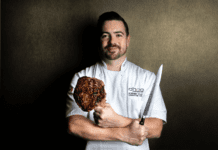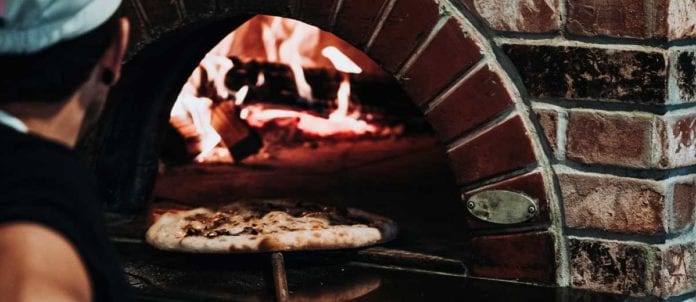From ovens to prep tools, a lot of work goes into preparing the perfect pizza.
Alessandro Vianello knows his way around pizza equipment. “I like all different types for different reasons,” says the executive chef for Kitchen Table Restaurants in Vancouver. The organization operates five restaurants that include three pizza establishments — Pizzeria Farina, Di Beppe and Farina a Legna. “A lot depends on the style of pizza you want to make.”
At the Pizzeria Farina takeout pizzeria, the equipment of choice is Allen, Texas-based Bakers Pride gas ovens. Di Beppe boasts Mississauga, Ont.-based Miwe’s electric ovens, while at Farina a Legna, a Vesuvio wood-fired oven from Tuscany, Italy stands centre stage.
Pizzas on deck Deck ovens are considered the basic workhorses of the pizza world. “There’s no crazy functionality for the most part,” Vianello says. “You just turn them on and that’s it. The one difference is, with gas you have only bottom heat, which requires a bit more control. Electric is very good because you have top and bottom heat. However, they draw a lot of power and not all buildings have enough.”
Domenic Primucci, president of Toronto-based Pizza Nova, says a vast majority of his operations use natural-gas deck ovens. “I prefer gas deck ovens over conveyor or rapid cook. They might take a little more care and training, but it’s what we like best. We only use electric if there’s no alternative, such as ground-floor operations in condo complexes where there are no gas runs.”
While they are workhorses, the stones in the deck ovens do require regular cleaning, he cautions. “You also need to regularly clean under the decks to keep the gas valves clean.”
Pizza Nova also has what Primucci calls a “gluten-free kit” at every location that includes a special screen to place under a pizza while baking in a dedicated chamber, so it doesn’t make contact with the stone surface, as well as separate peels and cutters.
In addition, Pizza Nova has mobile trailer units used at special events. The units contain two Bakers Pride deck ovens and are powered by propane gas. “It takes a bit of time to heat up the ovens, so we need to start them up a little earlier to get to the right heat.”
Depending on the brand, a two-deck oven would cost close to $20,000, with Bakers Pride a clear market leader in the category, says chef Gabriel Santos, corporate chef for Western Canada at W.D. Colledge in Vancouver. Countertop versions of deck ovens from brands such as Blodgett (Burlington, Vt.), Garland (Mississauga, Ont.) and Marsal (Essex Junction, Vt.), cost between $10,000 to $16,000, depending on the model and heating method.
To each their own
Wood-fired is Vianello’s pizza oven of choice from a personal perspective. “I love it — the flavour is incredible. But they do require a lot more management when it comes to regulating the temperature and moving pizzas around while cooking. If I were to open up another place with an open kitchen, that’s what I would go with, although they’re expensive.”
Wood/gas-fired ovens tend to carry a hefty price, but are well worth the investment for some operations, Santos says. Leading brands include Woodstone (Bellingham, Wash.), Marra Forni (Beltsville, Md.) and Beech (Eagle Farm, Australia). “Depending on the size you’re looking at, a minimum of $25,000 to $30,000 when you take into account the frame, installation and customization.”
A number of larger restaurant chains use conveyor ovens, Santos says. “You won’t get the char and crispiness that some restaurants want, but they’re incredibly easy to use. They do, however, require a bit of work in terms of fan power and air-flow adjustments to get just the right crispness.” Popular brands include Lincoln, TurboChef, Middleby Marshall and XLT and prices can range from $15,000 to $40,000 depending on size.
Rapid-cook ovens are ideal for restaurants that want to add pizza to the menu, but don’t have the space or ventilation system, Santos adds. “We usually recommend microwave assist for pizzas that are partially baked. If you’re working with raw dough, you don’t need the microwave function.” Brands include TurboChef, Merrychef and Ovention.
Rolling in the Dough
Ovens are only one part of achieving the perfect pizza. Dough mixers count among the absolute necessities for operators, Vianello says. “I have two spiral dough mixers and an old planetary mixer at our locations. I like the Italian brands best because they’re tried and tested.”
Sizes can range from 20 to 180 kg, but Vianello tends to settle for a middle-of-the-road 60 kg. size that costs about $6,000. “There are some mixers that cost less, but they don’t work as well when doing huge volumes. If you’re a restaurant offering pizza in addition to other cuisine, they might be okay. But, if you make large batches several times a day, you need to invest in one that is extremely reliable.”
Popular brands include Globe, Doyon and Cinelli.
A new item in Vianello’s repertoire is a dough press, which came with the new commissary space. “I’ve never tried one before but am willing to give it a shot. I know others who say they’re great and save on staffing.”
Prepping for Productivity
Another must is prep tables. These can vary a lot in terms of size and compartments (i.e. drawers, doors and number of toppings), Santos says. Brands include Beverage-Air, True and Continental.
Pizza Nova’s prep stations are custom made by a stainless-steel specialist. “You can get ones pre-done, but we often have to tweak sizes to maximize space depending on the store size,” Primucci says. “Typically, it’s a three-door fridge with a cabinet for the compressor, a refrigerated ingredient counter on top and marble prep surface.”
Depending on the type of operation, additional necessities may include a meat slicer, food processor for making sauces and a holding or proofing cabinet. Holding cabinet manufacturers include Alto-Shaam, Metro and Carter Hoffman.
Whatever the choices, equipment decisions start with the type of pizza you want to serve. From that point, there is no shortage of options available, from ovens to prep tools to smallwares.
By Denise Deveau

















